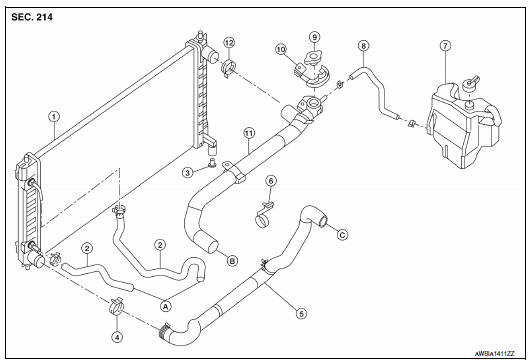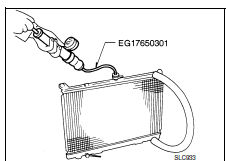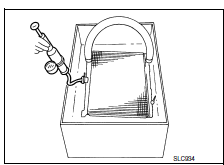Nissan Maxima Service and Repair Manual: Radiator
Exploded View

- Radiator
- CVT oil cooler hose
- Radiator drain plug
- Radiator hose (lower) clamp
- Radiator hose (lower)
- Radiator hose (lower) bracket
- Reservoir tank
- Reservoir hose
- Radiator cap
- Radiator cap adaptor
- Radiator hose (upper)
- Radiator hose (upper) clamp
- To CVT
- To water outlet
- To water inlet
Removal and Installation
WARNING: Do not remove the radiator cap when the engine is hot. Serious burns could occur from high pressure coolant escaping from the radiator. Wrap a thick cloth around the radiator cap. Slowly turn it a quarter turn to allow built-up pressure to escape. Carefully remove the radiator cap by turning it all the way.
NOTE: When removing components such as hoses, tubes/lines, etc., cap or plug openings to prevent fluid from spilling.
REMOVAL
- Drain coolant from radiator. Refer to CO-11, "Changing Engine Coolant".
- Remove hoodledge covers (LH/RH).
- Remove front bumper fascia. Refer to EXT-16, "Removal and Installation".
- Remove battery tray. Refer to PG-68, "Removal and Installation (Battery Tray)".
- Disconnect reservoir hose.
- Disconnect radiator hose (upper) and radiator hose (lower).
- Remove A/C condenser. Refer to HA-45, "CONDENSER : Removal and Installation".
- Disconnect the CVT oil cooler hoses
- Remove radiator.
CAUTION: Do not damage or scratch the radiator core when removing.
INSTALLATION
Installation is in the reverse order of removal.
- After installation refill engine coolant and check for leaks. Refer to and CO-10, "System Inspection".
CAUTION: Do not spill coolant in engine compartment. Use a shop cloth to absorb coolant.
INSPECTION
Radiator
- Check radiator for mud or clogging. If necessary, clean radiator as follows.
CAUTION:
- Be careful not to bend or damage the radiator fins.
- When radiator is cleaned on-vehicle, remove surrounding parts in order to access the radiator core. Tape the harness and electrical connectors to prevent water from entering.
- Spray water to the back side of the radiator core using a side to side motion from the top down.
- Stop spraying when debris no longer flows from radiator core.
- Blow air into the back side of radiator core using a side to side motion from the top down.
- Use compressed air lower than 490 kPa (5 kg/cm2, 71 psi) and keep distance more than 30 cm (11.8 in).
- Continue to blow air until no water sprays out.
- Inspect radiator for leaks as follows:
- Apply pressure using Tool.

Tool number : EG17650301 (J-33984-A)
Leakage test pressure : Refer to CO-27, "Radiator".
WARNING: To prevent the risk of the hose coming undone while under pressure, securely fasten it down with a hose clamp.
Attach a hose to the oil cooler as well.

- Check for leaks.
 Cooling fan
Cooling fan
Removal and Installation
Radiator cooling fan assembly
WARNING:
Do not remove the radiator cap when the engine is hot. Serious burns could occur
from high pressure
coolant escaping from ...
Other materials:
U1000 CAN comm circuit
Description
CAN (Controller Area Network) is a serial communication line for real time
application. It is an on-vehicle multiplex communication line with high data
communication speed and excellent error detection ability. Many electronic
control units are equipped on a vehicle and each contr ...
Diagnosis system (BCM)
COMMON ITEM
COMMON ITEM : CONSULT Function (BCM - COMMON ITEM)
APPLICATION ITEM
CONSULT performs the following functions via CAN communication with BCM.
Direct Diagnostic Mode
Description
Ecu Identification
The BCM part number is displayed
Self Diagnostic R ...
Automatic air conditioner system
System Diagram
CONTROL SYSTEM
The control system consists of input sensors, switches, the A/C auto amp.
(microcomputer) and outputs. The
relationship of these components is as shown in the figure below:
System Description
CONTROL OPERATION
Display
The operation status of the HVAC system ...
Nissan Maxima Owners Manual
- Illustrated table of contents
- Safety-Seats, seat belts and supplemental restraint system
- Instruments and controls
- Pre-driving checks and adjustments
- Monitor, climate, audio, phone and voice recognition systems
- Starting and driving
- In case of emergency
- Appearance and care
- Do-it-yourself
- Maintenance and schedules
- Technical and consumer information
Nissan Maxima Service and Repair Manual
0.0068

